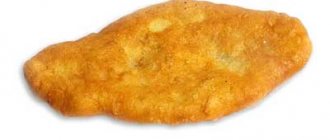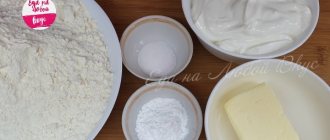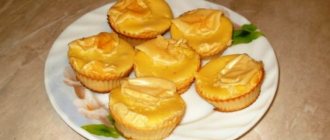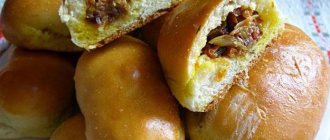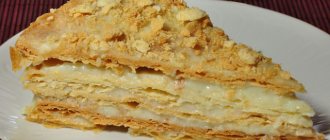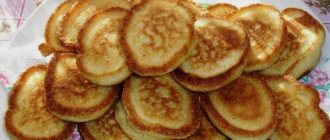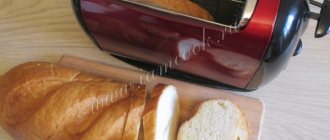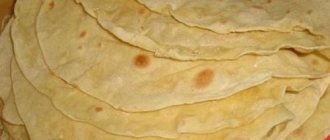Dietary properties:
What calorie content the pies have, what dietary properties they have, all this is of great interest to those who lead a healthy lifestyle and monitor their health and figure. So we will try to answer these questions in the next article.
So here it is:
Baking has always taken pride of place on the table. It is no coincidence that many Russian proverbs and sayings are dedicated specifically to pies, and not to any other dishes. Pies have long been considered a festive dish and a symbol of hospitality, which is why it is said that “a hut is not red in its corners, but red in its pies.”
Our mothers and grandmothers always baked cakes, cookies and pies for the holidays, and each family kept its own time-tested recipes. And although the choice of products was not as large as it is now, the baked goods always turned out surprisingly tasty. Today, a variety of confectionery products can be easily bought in any store, but sometimes you really want to remember the taste of a freshly baked bun, familiar from childhood, or surprise your guests with an incredibly beautiful cake made by yourself.
It is generally accepted that preparing homemade confectionery takes a lot of time, and that is why many housewives bake extremely rarely. Meanwhile, buns, pies, bagels, muffins, rolls can be baked in less than an hour, and from quite affordable products.
In order for the pies to be tasty, you need to prepare the dough correctly. There are two ways to prepare yeast dough - straight and sponged.
The sponge method is used to prepare dough mainly for products with a small amount of baked goods (sugar, butter, eggs) and dough of weak consistency - for pancakes, pancakes, fried pies, etc. The sponge method is used to make richer products.
Approximate layout for 1 kg of flour: pressed yeast 10–40 g, salt 12–15 g, water or milk from 400 to 500 g
The amount of yeast used to prepare the dough depends on its quality and the temperature conditions under which the dough ferments. For example, the worse the quality of the yeast and the lower the temperature, the more of it should be added.
When kneading the same type of yeast dough, the liquid norms may change in one direction or another. Thus, the amount of liquid for pies made from yeast dough can vary from 45 to 55% by weight of flour. This is explained by the degree of moisture in the flour: the more moisture the flour contains, the less it absorbs, and vice versa.
In addition, the drier the flour, the higher the yield of finished products. In accordance with this, the flour consumption rates specified in recipes for baked goods, depending on the moisture content of the flour, should be reduced or increased by an average of one percent for each percentage deviation of the flour moisture content from the norm according to the standard.
To obtain a fluffy product and increase baking, you need to take flour containing 30–40% good gluten.
Products prepared with milk rather than water are more tasty and aromatic, and their crust is shiny and has a good color.
Sugar significantly improves the quality of products, but it, like other raw materials, should be added to the dough strictly according to the norm. If the dough is very sweet, then fermentation slows down; In addition, when baking, the products quickly brown and are poorly baked. If the amount of sugar in the dough is insufficient, the product will hardly develop a golden brown crust.
Fats, softened to the consistency of sour cream, are added at the end of kneading the dough or when kneading it, this improves the fermentation of the dough.
Micro- and macroelements in Fried apples in dough
Fried apples in dough contain the following elements: Mono- and disaccharides, Cholesterol, Ash, Starch, Water, Organic acids, Dietary fiber, Unsaturated fatty acids, Sodium, Potassium, Phosphorus, Magnesium, Calcium, Sulfur, Copper, Boron, Silicon, Aluminum , Titanium, Strontium, Iodine, Manganese, Chromium, Fluorine, Molybdenum, Vanadium, Cobalt, Nickel, Rubidium, Selenium, Tin, Zinc, Iron, Chlorine.
| Micro and macro element | Meaning |
| Mono- and disaccharides, g. | 5,4 |
| Cholesterol, mg | 69,8 |
| Zola, Mr. | 0,6 |
| Starch, Mr. | 7,5 |
| Water, city | 79,4 |
| Organic acids, g. | 4,5 |
| Dietary fiber, g. | 1,4 |
| Unsaturated fatty acids, g | 0,4 |
| Sodium, mg | 35,4 |
| Potassium, mg | 215,3 |
| Phosphorus, mg | 52,1 |
| Magnesium, mg | 9,8 |
| Calcium, mg | 35,4 |
| Sulfur, mg | 35,1 |
| Copper, µg | 96,5 |
| Boron, µg | 278,8 |
| Silicon, mg | 1,2 |
| Aluminum, µg | 220,4 |
| Titanium, µg | 34,1 |
| Strontium, mcg | 84,1 |
| Iodine, mcg | 4,7 |
| Manganese, mg | 0,1197 |
| Chromium, µg | 2,8 |
| Fluorine, mcg | 16,6 |
| Molybdenum, mcg | 6,5 |
| Vanadium, mcg | 14,3 |
| Cobalt, µg | 2,2 |
| Nickel, µg | 12,3 |
| Rubidium, mcg | 26,3 |
| Selenium, mcg | 0,8 |
| Tin, µg | 1,9 |
| Zinc, mg | 0,3333 |
| Iron, mg | 1,6 |
| Chlorine, mg | 97,4 |
How many calories do they have?
Here's how much:
Naturally, the calorie content of pies depends on the filling and method of preparation.
Pay attention to this table:
Table of calorie content of pies and nutritional value (BJU) per 100 grams:
| Pies: | Bel, gr. | Fat, gr. | Angle, gr. | Cal, kcal. |
| Fried with onions and eggs | 9.0 | 9.6 | 34.0 | 259 |
| With onions and eggs in the oven | 8.6 | 9.1 | 26.0 | 214 |
| Fried with cabbage | 5.0 | 10.5 | 29.0 | 230 |
| With cabbage in the oven | 4.4 | 7.1 | 33.6 | 214 |
| Fried with potatoes | 6.2 | 10.0 | 17.7 | 244 |
| With potatoes in the oven | 4.4 | 2.5 | 35.0 | 190 |
| Fried with meat | 4.7 | 8.8 | 48.0 | 290 |
| With meat in the oven | 12.2 | 5.7 | 35.5 | 245 |
| Rice and egg | 10.3 | 7.6 | 35.0 | 250 |
| With apple | 5.6 | 4.7 | 54.0 | 286 |
| With cherry | 6.9 | 3.7 | 40.0 | 287 |
| With cottage cheese | 11.0 | 19.7 | 21.3 | 307 |
How many calories are in a lean mushroom pie?
Lenten pies with mushrooms
rich in vitamins and minerals such as:
vitamin B1 - 16.4%, vitamin B2 - 16.9%, vitamin B5 - 28.1%, vitamin B6 - 17.4%, vitamin B9 - 16.1%, vitamin C - 12%, vitamin E - 55 .8%, vitamin K - 13.5%, vitamin PP - 29.1%, potassium - 20.5%, silicon - 43.7%, magnesium - 15.6%, phosphorus - 28.5%, chlorine - 23.1%, iron - 16.4%, cobalt - 102.6%, manganese - 76.6%, copper - 24.4%, molybdenum - 13.8%, selenium - 35.5%, chromium - 13 .5%, zinc - 12.6%
- Vitamin B1
is part of the most important enzymes of carbohydrate and energy metabolism, providing the body with energy and plastic substances, as well as the metabolism of branched amino acids. A lack of this vitamin leads to serious disorders of the nervous, digestive and cardiovascular systems. - Vitamin B2
is involved in redox reactions, helps to increase the color sensitivity of the visual analyzer and dark adaptation. Insufficient intake of vitamin B2 is accompanied by impaired condition of the skin, mucous membranes, and impaired light and twilight vision. - Vitamin B5
is involved in protein, fat, carbohydrate metabolism, cholesterol metabolism, the synthesis of a number of hormones, hemoglobin, promotes the absorption of amino acids and sugars in the intestines, and supports the function of the adrenal cortex. A lack of pantothenic acid can lead to damage to the skin and mucous membranes. - Vitamin B6
is involved in maintaining the immune response, processes of inhibition and excitation in the central nervous system, in the transformation of amino acids, the metabolism of tryptophan, lipids and nucleic acids, promotes the normal formation of red blood cells, and maintaining normal levels of homocysteine in the blood. Insufficient intake of vitamin B6 is accompanied by decreased appetite, impaired skin condition, and the development of homocysteinemia and anemia. - Vitamin B9
as a coenzyme is involved in the metabolism of nucleic acids and amino acids. Folate deficiency leads to disruption of the synthesis of nucleic acids and proteins, resulting in inhibition of cell growth and division, especially in rapidly proliferating tissues: bone marrow, intestinal epithelium, etc. Insufficient folate intake during pregnancy is one of the causes of prematurity, malnutrition, and congenital deformities and child development disorders. A strong relationship has been shown between folate and homocysteine levels and the risk of cardiovascular disease. - Vitamin C
is involved in redox reactions, the functioning of the immune system, and promotes the absorption of iron. Deficiency leads to loose and bleeding gums, nosebleeds due to increased permeability and fragility of blood capillaries. - Vitamin E
has antioxidant properties, is necessary for the functioning of the gonads and heart muscle, and is a universal stabilizer of cell membranes. With vitamin E deficiency, hemolysis of erythrocytes and neurological disorders are observed. - Vitamin K
regulates blood clotting. A lack of vitamin K leads to an increase in blood clotting time and a decreased level of prothrombin in the blood. - Vitamin PP
is involved in redox reactions of energy metabolism. Insufficient vitamin intake is accompanied by disruption of the normal condition of the skin, gastrointestinal tract and nervous system. - Potassium
is the main intracellular ion that takes part in the regulation of water, acid and electrolyte balance, and is involved in the processes of conducting nerve impulses and regulating blood pressure. - Silicon
is included as a structural component in glycosaminoglycans and stimulates collagen synthesis. - Magnesium
is involved in energy metabolism, the synthesis of proteins, nucleic acids, has a stabilizing effect on membranes, and is necessary to maintain the homeostasis of calcium, potassium and sodium. A lack of magnesium leads to hypomagnesemia, an increased risk of developing hypertension and heart disease. - Phosphorus
takes part in many physiological processes, including energy metabolism, regulates acid-base balance, is part of phospholipids, nucleotides and nucleic acids, and is necessary for the mineralization of bones and teeth. Deficiency leads to anorexia, anemia, and rickets. - Chlorine
is necessary for the formation and secretion of hydrochloric acid in the body. - Iron
is part of proteins with various functions, including enzymes. Participates in the transport of electrons and oxygen, ensures the occurrence of redox reactions and activation of peroxidation. Insufficient consumption leads to hypochromic anemia, myoglobin deficiency atony of skeletal muscles, increased fatigue, myocardiopathy, and atrophic gastritis. - Cobalt
is part of vitamin B12. Activates enzymes of fatty acid metabolism and folic acid metabolism. - Manganese
is involved in the formation of bone and connective tissue, and is part of enzymes involved in the metabolism of amino acids, carbohydrates, and catecholamines; necessary for the synthesis of cholesterol and nucleotides. Insufficient consumption is accompanied by slower growth, disturbances in the reproductive system, increased fragility of bone tissue, and disturbances in carbohydrate and lipid metabolism. - Copper
is part of enzymes that have redox activity and are involved in the metabolism of iron, stimulates the absorption of proteins and carbohydrates. Participates in the processes of providing oxygen to the tissues of the human body. Deficiency is manifested by disturbances in the formation of the cardiovascular system and skeleton, and the development of connective tissue dysplasia. - Molybdenum
is a cofactor for many enzymes that ensure the metabolism of sulfur-containing amino acids, purines and pyrimidines. - Selenium
is an essential element of the antioxidant defense system of the human body, has an immunomodulatory effect, and is involved in the regulation of the action of thyroid hormones. Deficiency leads to Kashin-Beck disease (osteoarthritis with multiple deformities of the joints, spine and limbs), Keshan disease (endemic myocardiopathy), and hereditary thrombasthenia. - Chromium
is involved in the regulation of blood glucose levels, enhancing the effect of insulin. Deficiency leads to decreased glucose tolerance. - Zinc
is part of more than 300 enzymes and is involved in the processes of synthesis and breakdown of carbohydrates, proteins, fats, nucleic acids and in the regulation of the expression of a number of genes. Insufficient consumption leads to anemia, secondary immunodeficiency, liver cirrhosis, sexual dysfunction, and the presence of fetal malformations. Research in recent years has revealed the ability of high doses of zinc to disrupt the absorption of copper and thereby contribute to the development of anemia.
Pies for weight loss:
And further:
How to make good dough?
Before putting the dough, be sure to sift the flour to remove impurities, lumps, and also introduce air - the dough will rise better.
When making a dough or dough, do not pour flour into the liquid, but, on the contrary, dilute the flour with milk or water, stirring thoroughly all the time so that there are no lumps.
Do not let the dough rest - the pies will taste sour. It is enough to stand for 3 hours, but be sure to stay warm.
To make the rice for the filling white and crumbly, add a little vinegar to the water where it is cooked 5 minutes before it is cooked. Drain in a colander and rinse well with cold water.
You almost always need to add hard-boiled eggs to the pie filling. Boil them in salted water so that they do not leak out; if the shell is cracked, at a vigorous boil, then the protein will be hard.
Similar Recipes
To keep the pies soft and golden brown...
Fry the pies not in a frying pan, but in a thick-bottomed pan, covered with a lid. Then the pies will turn out more rosy and softer.
- Read completely
To make fried yeast pies fluffy and beautiful Fried yeast pies will be more airy, beautiful and fluffy if you follow the following recommendations: – be sure to sift the flour – in addition to the standard raising of the dough, let it rise...
- Read completely
How to make jam for pies thicker? Too liquid jam for pies can be boiled until tender. You can also add crushed corn flakes or crushed crackers to the jam.
- Read completely
How to determine the type and quality of dry yeast To choose a recipe that is more time-saving, you need to know some differences in the types of yeast: * FRESH or “wet” - in briquettes, it is enough to dissolve them in water at room temperature. * DRY...
- Read completely
How to preserve fresh cucumbers for a long time Sometimes it happens that for some unknown reason fresh cucumbers wither. And I want to keep them fresh for much longer. Here's the method: take a rag and wet it with cold water. Cucumbers are wrapped in it...
- Read completely
How to freeze champignons Wash the washed champignons with a paper towel, clean the caps and “skirts”. Cut into thin slices, arrange in a single layer and place in the freezer. After 4-6 hours, the mushrooms are ready. Put it in poly...
- Read completely
How to clean champignons. As you know, champignons are not washed in water - they swell from it. But you still need to clean these mushrooms, even though they are clean in themselves. You can clean the champignons using a regular brush with stiff bristles...
- Read completely
Ingredients of a pie with cabbage
A pie with cabbage, which is quite high in calories, is made from flour dough and cabbage. The dough can be prepared with yeast or kefir. The cabbage is pre-simmered in oil so that it is soft, juicy and crispy. If the pie is fried in a frying pan or deep-fried, then the calorie content of such baking increases. Therefore, it is better to bake the pies in the oven rather than fry them in a frying pan in a lot of oil.
The calorie content of fried pies will be slightly higher than those baked in the oven.
Pies, like any other food, contain minerals and vitamins:
| Microelement | % of daily value in 100 g daily value |
| vitamin A | 22,4 |
| vitamin B1 | 35 |
| vitamin B2 | 35 |
| vitamin C | 12,4 |
| vitamin E | 24 |
| chlorine | 12,2 |
| cobalt | 23,5 |
| manganese | 19,5 |
| molybdenum | 13,6 |
Tips for losing weight
A pie with cabbage is not the best food option for those who want to lose weight. The abundance of calories and carbohydrates contained in baked goods will significantly slow down this process. You can include such high-calorie dishes in your diet if you have high physical activity. It is advisable to eat pies for breakfast, since the calories that enter the body before lunch are completely consumed by the body and are not stored as fat deposits.
We should not forget about the norm - it is allowed to have 1 pie for breakfast 1-2 times a week. As described above, it is better to give preference to pies prepared in the oven according to recipes that do not include butter or margarine. Since it is difficult to buy relatively “healthy” pies without harmful additives in the store, they are prepared independently.
How to reduce the calorie content of pies?
In order to reduce the calorie content of the finished cabbage pie at the end, you should approach the process of preparing the dough and filling in a non-trivial way:
- cabbage itself is low in calories, but when stewed in sunflower oil it becomes much more filling and harder to digest. It is better to use olive oil instead of sunflower oil, or bake the cabbage in a sleeve in its own juice and then chop it for filling;
- instead of yeast dough, it is better to make dough with low-fat kefir;
- To prepare the dough, in addition to wheat flour, they take another, more healthy one - buckwheat, oatmeal, corn. It will not be possible to completely replace wheat flour with them, since the baked goods will not rise, but they will partially reduce the calorie content of the finished pie;
- When kneading the dough, you should not add trans fats (margarine), as this is very harmful;
- for dietary baking, do not add butter to the dough;
- frying pies in oil is strictly not recommended; pies should be baked in the oven, while the baking sheet is covered with parchment and minimally greased with butter;
- There is no need to brush the top of the pies with egg, this will add extra calories to the product.
